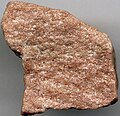English: Quartzite (metaquartzite) (3.1 centimeters across at its widest)
Metamorphic rocks result from intense alteration of any previously existing rocks by heat and/or pressure and/or chemical change. This can happen as a result of regional metamorphism (large-scale tectonic events, such as continental collision or subduction), burial metamorphism (super-deep burial), contact metamorphism (by the heat & chemicals from nearby magma or lava), hydrothermal metamorphism (by superheated groundwater), shear metamorphism (in or near a fault zone), or shock metamorphism (by an impact event). Other categories include thermal metamorphism, kinetic metamorphism, and nuclear metamorphism. Many metamorphic rocks have a foliated texture, but some are crystalline or glassy.
Quartzite is a common, crystalline-textured, intermediate- to high-grade metamorphic rock. It forms by metamorphism of quartzose sandstones or siltstones. Quartzite can be entirely composed of interlocking quartz crystals, or the original sand grains may still be visible. This rock is hard (H = 7), will not bubble in acid (unlike marble), and can be almost any color.
The term “quartzite” has been used in geology to refer to crystalline, quartzose metamorphic rocks and to hard, well-cemented quartzose sandstones that have not been subjected to metamorphism. It is difficult to not call hard, well-cemented sandstones “quartzite” (for example, the Clinch Quartzite in the Appalachian Mountains & the Eureka Quartzite of the Great Basin in western USA). But the Clinch and Eureka aren’t metamorphic rocks. The term metaquartzite has been used by some geologists to refer to crystalline-textured, quartzose rocks that have been metamorphosed. This implies that “quartzite” be restricted to well-cemented, non-metamorphosed sandstones. I don’t often see the term metaquartzite used in the geologic literature.


